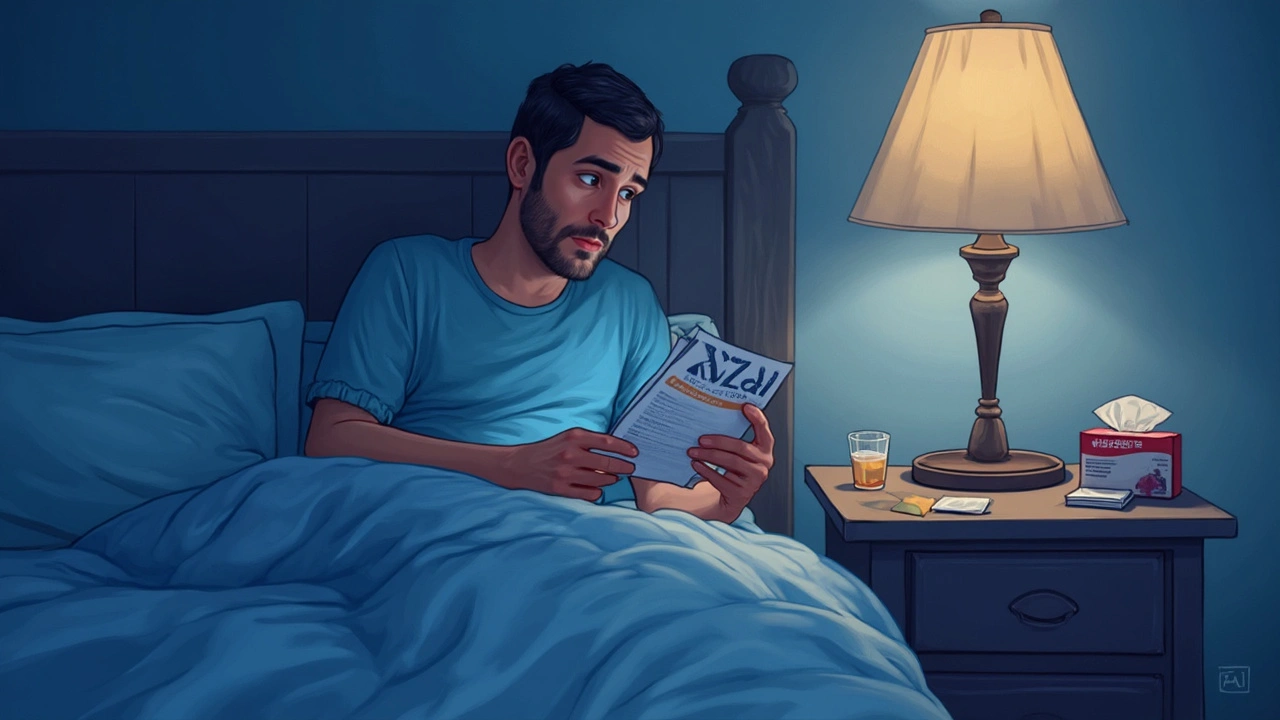Waking up sneezing, your eyes itching, and your nose running like a leaky faucet isn’t exactly the ideal start to any day. For millions of people living with allergies, that’s just another Tuesday. The search for relief can get frustrating fast—one antihistamine that often stands out is Xyzal. But is this little tablet the answer to a sniffle-free life? Or are you just trading one set of problems for another? Let’s dig into the details, break things down, and see where Xyzal fits in the vast allergy medicine universe.
What is Xyzal, and How Does It Work?
Xyzal isn’t some trendy new supplement or a miracle cure. Its real name is levocetirizine dihydrochloride, and it’s an antihistamine—basically, it blocks the activity of histamine, the sneaky chemical your body releases when it thinks pollen, pet dander, or dust mites are attacking you. When your body’s on allergy alert, histamine causes swelling, itching, runny nose, watery eyes, and even hives. By taking Xyzal, you’re telling your system to chill out and stop overreacting to harmless stuff.
The interesting bit? Xyzal is a so-called "second-generation" antihistamine. That’s a fancy way of saying scientists tweaked the molecules to help you fight allergies without knocking you out for the count, like Benadryl (a first-gen classic) sometimes does. Its active ingredient, levocetirizine, is basically a purified version of cetirizine (the stuff in Zyrtec). This tweak means Xyzal is engineered to be both potent and less sedating, which a lot of allergy sufferers appreciate—especially if they actually want to be productive during the day.
If you get technical, Xyzal binds tightly to histamine H1-receptors—the places in your body where histamine wants to create chaos. By blocking these, you get fewer allergy symptoms. Some research also hints that it might have small anti-inflammatory perks, although its main job is still allergy symptom control.
The FDA approved Xyzal for adults and kids (down to age six months) for both seasonal and indoor allergies. It’s also used for treating chronic hives and itching. If you’re trying to pick between Xyzal and its cousin Zyrtec, know this: some head-to-head trials suggest Xyzal may work a touch faster, but in the real world, most people won’t notice a radical difference. Where Xyzal sometimes wins is for people who find regular cetirizine too sedating, or for those who haven’t had much luck with other OTC allergy pills.
Who Should Consider Xyzal?
Choosing the right allergy medicine sometimes feels like playing roulette—and people switch brands and doses hoping to land on the magic combination. Xyzal appeals to several groups, from busy parents and shift workers to those who hate the zombie-like drowsiness older meds cause. Here are some common reasons folks add it to their medicine cabinets:
- They need fast, effective *and* all-day (or all-night) allergy relief.
- They’re fed up with waking up with dry eyes and a humidifier never helps.
- They prefer taking their antihistamine at night so it tackles evening and overnight symptoms.
- They need a non-drowsy option to avoid zoning out at school or work.
- Parents want safe options for their kids—Xyzal is approved for kids as young as six months (with proper dosing, of course).
The usual daily dose for adults and kids over 12 is 5 mg, generally taken at bedtime. Kids aged 6-11 usually get 2.5 mg, and smaller doses go to even younger children. For some, especially older adults or people with kidney problems, doctors may advise lower doses or avoid it altogether.
Some people are extra sensitive to drowsiness—even from newer antihistamines. If you’ve found Zyrtec leaves you sleepy, there’s still a chance Xyzal could do the same. The "less drowsy" claim isn’t a guarantee; about 6-10% report feeling more tired than usual. For folks with heavy machinery jobs, or anyone using sharp tools, you’ve got to be honest with yourself about how this stuff affects you.
Xyzal remains a top pick for:
- Seasonal allergies (like ragweed, grass pollen, tree pollen)
- Year-round allergies (think pets, dust mites, mold)
- Chronic urticaria (long-term hives with no obvious trigger)
- Nighttime nose and throat itch keeping you awake
People with kidney problems need special caution because Xyzal is cleared by your kidneys. If you have severe renal impairment, your doctor will usually steer you to another option. The same goes for those who are pregnant or breastfeeding—always talk to your provider, because data in these groups is pretty light.
One cool thing for parents: Xyzal’s oral solution makes giving doses to young kids easier, skipping the mess of crushed pills or weird-tasting chewables.

Possible Side Effects and How to Handle Them
Usually, Xyzal’s side effects are on the milder side, but that doesn’t mean you should ignore them. The one everyone worries about first is drowsiness. Around 6-10% of people say it makes them sleepy, especially in the first days. For most, this fades after a week or so as your body adjusts—but if it doesn’t, or if you’re nodding off at your desk, Xyzal might not be your best match. Here are the other usual suspects:
- Dry mouth or throat—that annoying cotton-mouth feeling
- Fatigue or feeling sluggish
- Headache
- Upset stomach or nausea (less common but it happens)
- Stuffed-up nose (odd, considering it’s meant for allergy relief!)
Very rarely, folks get more serious reactions—like difficulty urinating, rapid heartbeat, or severe allergic response (think swelling, rash, trouble breathing). These aren’t common, but if you notice anything like that, you definitely need to stop and call for help.
Kids sometimes act a little different on Xyzal than adults. They might seem more restless, irritable, or even wired—so if your little one is bouncing off the walls or crashing during the day, their allergy meds could be a factor.
For folks juggling lots of medications, it pays to check for interactions. Xyzal generally plays nice with most other drugs but combining it with alcohol or sedating meds can stack up the sleepy effects. Always chat with your pharmacist or doctor if you’re on antidepressants, anti-seizure drugs, or other allergy remedies.
Common sense tips to keep side effects in check:
- Take Xyzal in the evening, especially your first time, so you're not drowsy when you need to be alert.
- Avoid mixing with booze (your liver will thank you).
- Stay hydrated to help combat dry mouth.
- Don’t drive or operate equipment until you know how it affects you personally.
- If you’re caring for elderly relatives, double-check with their doc about possible interactions with their usual meds.
Here’s a quick look at the numbers for common Xyzal side effects compared with a placebo, pulled straight from clinical trial summaries:
| Side Effect | Xyzal (5mg) | Placebo |
|---|---|---|
| Drowsiness | 6.1% | 2.9% |
| Dry Mouth | 2.7% | 1.3% |
| Headache | 1.4% | 1.1% |
The chance of something serious happening is tiny—less than 1 in 1,000.
How Xyzal Stacks Up Against Other Allergy Medicines
If you walk down any pharmacy aisle, you’ll see a wall of allergy pills: Claritin, Allegra, Zyrtec, Benadryl, and others lined up. What’s the best? There’s no universal winner, since everyone’s biology is annoyingly unique. But here’s a quick side-by-side so you can see what makes Xyzal worth a try (or not):
- Xyzal (levocetirizine): Fast onset (often within an hour); works 24 hours; somewhat more likely than Allegra or Claritin to cause drowsiness but less than Zyrtec. Great for overnight or severe symptoms.
- Zyrtec (cetirizine): Similar in strength, but about 13% of people say it makes them drowsy, especially if taken in the morning. Slightly longer track record.
- Claritin (loratadine): Slowest onset (up to 3 hours), often called the least sedating. Perfect if you want to skip drowsy side effects but maybe not strong enough for all symptoms.
- Allegra (fexofenadine): Super low sedation, often the favorite for daytime use, but can sometimes be pricier or need to be timed around food.
- Benadryl (diphenhydramine): Works quickly but sedates hard—strictly one for bedtime emergencies or allergic reactions, not daily use.
Studies suggest that Xyzal may block more of your pesky histamine receptors for longer compared to Claritin and sometimes even Zyrtec. One large European study found that Xyzal reduced allergy symptoms for more hours each day compared to loratadine, and users needed fewer rescue medications like nasal sprays.
But here’s a fun twist: the FDA allows all four (except Benadryl for daily allergies) to be sold fully over the counter in the U.S., so anyone can comparison-shop or even split-test them. Some folks cycle through two antihistamines, especially during heavy pollen months, but do it only with your doctor’s okay.
Price-wise, generic levocetirizine is nearly always cheaper than name-brand Xyzal. If you’re after savings, look for the store’s own version—same ingredient, smaller dent in your wallet.

Tips for Getting the Most Out of Xyzal
There’s more to beating allergies than popping a pill and hoping for the best. Here’s the lowdown on squeezing out every drop of relief—without running into roadblocks:
- Allergy meds work better before symptoms kick in. Start taking Xyzal a few days before pollen spikes in your area.
- Take it at the same time each night. Consistency helps your body get into a rhythm, so you wake up clearer and feel steady relief.
- Use air purifiers, shower before bed, and wash your bedding often to cut down on triggers.
- Track your symptom patterns, maybe with an app; this info helps your doctor fine-tune your asthma and allergy plan if Xyzal alone isn’t enough.
- If you miss a dose, just take it the next day—don’t double up.
- Watch out for hidden allergy triggers like strong perfumes, smoke, or even certain foods if you notice flares that meds aren’t fixing.
- If you have severe asthma, ask your doctor if Xyzal is the best fit for you—sometimes nasal steroid sprays are a better choice for blocking all symptoms.
Don’t ignore perks, either: many insurance plans now cover both branded and generic Xyzal, especially for those with chronic hives. If you need to request prior authorization, being able to explain other medications you’ve already tried can simplify the process.
Some people experiment with splitting the standard 5 mg pill in half, especially those who feel foggy or overly tired. There aren’t any official studies on this, but doctors sometimes recommend lower doses for sensitive folks—just check with your provider to make sure you’re still getting enough relief.
One unusual tip: If you work variable shifts or international flights, ask if you can switch your dosing time to fit your sleep schedule—Xyzal is forgiving in this way, giving you more freedom to adapt without losing relief.
Before you settle on Xyzal as your long-term allergy warrior, talk to your doctor if you have kidney problems, take lots of medications, or notice symptoms aren't easing up after two weeks. Sometimes tiny tweaks make a big difference, or you might need a combo approach with nasal sprays or allergen immunotherapy. Being honest with yourself and your doctor sets you up for success—nobody needs to suffer through allergy season if there’s something better that fits your everyday life.








laura lauraa June 28, 2025
Oh, Xyzal… the pharmaceutical equivalent of a whispering therapist who says, "I hear you, but I’m also going to make you nap for eight hours." 🤭 I took it once-just once-because I was desperate, and woke up feeling like my brain had been replaced with wet cotton wool soaked in lavender-scented regret. I stared at the ceiling for 47 minutes wondering if I was dead or just… legally classified as a furniture item. The dry mouth? Oh, it was exquisite. Like licking a desert that had been microwaved. I’m not saying it works-I’m saying it works TOO WELL. And yes, I still use it. Because I’m a masochist with a prescription.
steve stofelano, jr. June 29, 2025
As a medical educator with over two decades of clinical experience, I find this article to be a commendably balanced overview of levocetirizine’s pharmacological profile. The distinction between first- and second-generation antihistamines is accurately delineated, and the emphasis on renal clearance mechanisms is particularly prudent. I would only add that in geriatric populations, even the "non-sedating" antihistamines can exert anticholinergic effects that exacerbate cognitive decline or urinary retention-especially when combined with polypharmacy. Xyzal’s once-daily dosing and predictable pharmacokinetics make it a favorable option in stable outpatient regimens, provided renal function is monitored. The comparative efficacy data against loratadine and fexofenadine remains clinically relevant, particularly in patients with persistent rhinoconjunctivitis. Always individualize therapy.
Savakrit Singh June 29, 2025
Bro, Xyzal is the real MVP 🙌 but let’s be real-6% drowsiness? That’s like saying "this bomb is only 6% explosive." 😅 I’m from India, and here, people take Zyrtec like candy, then wonder why they’re napping during pujas. Xyzal? Less sleepy, same power. My cousin’s 3-year-old takes 1.25mg nightly-no more midnight sneezing fits, no more red eyes. But man, dry mouth? 😖 Gotta chug water like it’s a job. And don’t even get me started on the price. Generic? Yes. Brand? No. Save your cash. 📉💊 #PharmaIsARacket
Cecily Bogsprocket July 1, 2025
I’ve been on Xyzal for three allergy seasons now, and I can’t tell you how much it’s changed my life. Before this, I was constantly exhausted-not because I wasn’t sleeping, but because my body was fighting invisible wars every night. The itching, the congestion, the feeling of being perpetually half-awake… it wore me down. Xyzal didn’t just reduce symptoms-it restored my sense of normalcy. I sleep through the night now. I wake up without reaching for tissues. I can actually enjoy the spring breeze without dreading the aftermath. I know it’s not magic. I know it doesn’t work for everyone. But for those of us who’ve spent years trying one pill after another, this isn’t just medicine-it’s peace. And that’s worth more than any price tag.
Jebari Lewis July 2, 2025
Wait-so you’re telling me this thing is approved for infants as young as six months? 🤯 I’m not saying it’s wrong, but if your kid’s allergies are so severe they need pharmaceutical intervention at that age, maybe we need to look at the environment, not just the symptom suppression. Also, why is it still branded when the generic is identical? Big Pharma’s playing us like a fiddle. And yes, I’ve tried Claritin, Allegra, Zyrtec-Xyzal was the only one that didn’t leave me feeling like a zombie with a head cold. But I still take it at night. Always. And I drink water. Always. And I don’t drive for 6 hours after. Always. And if you’re not tracking your triggers? You’re just guessing. Get an app. Track pollen. Track meals. Track sleep. Allergies aren’t random-they’re data. And you’re ignoring the dataset. 📊